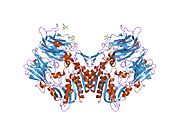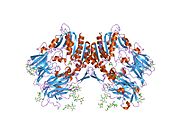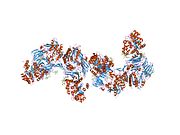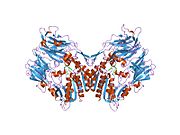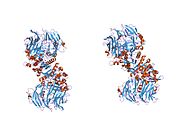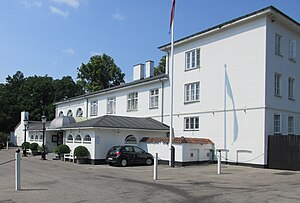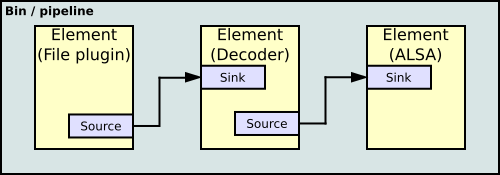디펩티딜펩티다아제-4
Dipeptidyl peptidase-4디펩티딜 펩티다아제-4(DPP4)는 아데노신 디아미나제 복합 단백질 2 또는 CD26(분화 26 군집)으로도 알려져 있으며, 인간에서 DPP4 유전자에 의해 인코딩되는 단백질이다.[5]DPP4는 FAP, DPP8, DPP9와 관련이 있다.이 효소는 1966년 홉수하부(Hopsu-Havu)와 글렌너(Glenner)에 의해 발견되었으며,[6] 화학에 관한 다양한 연구 결과 디펩티딜 펩티다아제 IV[DP IV]라고 불렸다.
함수
DPP4 유전자에 의해 인코딩된 단백질은 대부분의 세포 유형의 표면에 발현된 효소로 면역 조절, 신호 전달, 사멸과 관련이 있다.제2종 투과형 당단백질이지만 세포내 및 투과형 부위가 부족한 수용성 형태는 혈장과 다양한 체액에 존재한다.DPP-4는 폴리펩타이드의 N-terminus에서 X-proline 또는 X-alanine dipptide를 분쇄하는 세린 엑소펩타이드제다.순환 아미노산 프로라인을 포함하는 펩타이드 결합은 다수의 프로테아제 및 N-단자 X-프로라인 "차폐" 다양한 바이오펩타이드에 의해 분해될 수 없다.[7]그러므로 세포외 프로라인 특정 보호제는 이러한 생물흡수제의 규제에 중요한 역할을 한다.
DPP-4는 성장인자, 케모카인, 신경펩타이드, 바소액티브 펩타이드 등을 포함한 광범위한 기판을 분쇄하는 것으로 알려져 있다.[8][9]갈라진 기질들은 대부분의 경우 생물학적 활성을 잃지만, 케모킨 RANTES와 신경펩타이드 Y의 경우 DPP-4 매개 분열은 수용체 아형 결합의 변화를 이끈다.[8]
DPP4는 포도당 신진대사에 큰 역할을 한다.GLP-1과 같은 증가율의 저하를 책임진다.[10]게다가, 그것은 일부 종양의 발달에 억제제 역할을 하는 것으로 보인다.[11][12][13][14]
DPP-4는 또한 아데노신 디아미노아제 효소를 특별히 높은 친화력으로 결합시킨다.이 상호작용의 중요성은 아직 규명되지 않았다.
동물학
동물 연구는 간, 신장 등 다양한 장기의 섬유화 발달에 있어 그것의 병균적 역할을 제시한다.[15][16]
임상적 유의성
CD26/DPPIV는 종양 생물학에서 중요한 역할을 하며 세포 표면이나 혈청 중 어느 한쪽에서 수치가 증가하고 다른 일부 종양에서는 감소하는 등 다양한 암의 표식으로서 유용하다.[17]
디펩티딜 펩티다아제-4 억제제라 불리는 경구 저혈당제 종류는 이 효소의 작용을 억제하여 체내 증분 효과를 연장시키는 작용을 한다.[18]
중동호흡기증후군 코로나바이러스가 DPP4와 결합하는 것으로 밝혀졌다.기도(폐 등)와 신장의 세포 표면에서 발견된다.과학자들은 바이러스의 세포 진입을 막음으로써 이것을 그들에게 유리하게 사용할 수 있을지도 모른다.[19]
참고 항목
참조
- ^ a b c GRCh38: 앙상블 릴리스 89: ENSG00000197635 - 앙상블, 2017년 5월
- ^ a b c GRCm38: 앙상블 릴리스 89: ENSMUSG00000035000 - 앙상블, 2017년 5월
- ^ "Human PubMed Reference:". National Center for Biotechnology Information, U.S. National Library of Medicine.
- ^ "Mouse PubMed Reference:". National Center for Biotechnology Information, U.S. National Library of Medicine.
- ^ Kameoka J, Tanaka T, Nojima Y, Schlossman SF, Morimoto C (July 1993). "Direct association of adenosine deaminase with a T cell activation antigen, CD26". Science. 261 (5120): 466–9. Bibcode:1993Sci...261..466K. doi:10.1126/science.8101391. PMID 8101391.
- ^ Hopsu-Havu VK, Glenner GG (1966). "A new dipeptide naphthylamidase hydrolyzing glycyl-prolyl-beta-naphthylamide". Histochemie. Histochemistry. Histochimie. 7 (3): 197–201. doi:10.1007/bf00577838. PMID 5959122. S2CID 9674831.
- ^ Vanhoof G, Goossens F, De Meester I, Hendriks D, Scharpé S (June 1995). "Proline motifs in peptides and their biological processing". FASEB Journal. 9 (9): 736–44. doi:10.1096/fasebj.9.9.7601338. PMID 7601338. S2CID 37551773.
- ^ a b Mentlein R (November 1999). "Dipeptidyl-peptidase IV (CD26)--role in the inactivation of regulatory peptides". Regulatory Peptides. 85 (1): 9–24. doi:10.1016/S0167-0115(99)00089-0. PMID 10588446. S2CID 22354304.
- ^ Chen X (2006). "Biochemical properties of recombinant prolyl dipeptidases DPP-IV and DPP8". Dipeptidyl Aminopeptidases. Advances in Experimental Medicine and Biology. Vol. 575. pp. 27–32. doi:10.1007/0-387-32824-6_3. ISBN 978-0-387-29058-4. PMID 16700505.
- ^ Barnett A (November 2006). "DPP-4 inhibitors and their potential role in the management of type 2 diabetes". International Journal of Clinical Practice. 60 (11): 1454–70. doi:10.1111/j.1742-1241.2006.01178.x. PMID 17073841. S2CID 2645092.
- ^ Pro B, Dang NH (October 2004). "CD26/dipeptidyl peptidase IV and its role in cancer". Histology and Histopathology. 19 (4): 1345–51. doi:10.14670/HH-19.1345. PMID 15375776.
- ^ Masur K, Schwartz F, Entschladen F, Niggemann B, Zaenker KS (December 2006). "DPPIV inhibitors extend GLP-2 mediated tumour promoting effects on intestinal cancer cells". Regulatory Peptides. 137 (3): 147–55. doi:10.1016/j.regpep.2006.07.003. PMID 16908079. S2CID 2857735.
- ^ Wesley UV, McGroarty M, Homoyouni A (February 2005). "Dipeptidyl peptidase inhibits malignant phenotype of prostate cancer cells by blocking basic fibroblast growth factor signaling pathway". Cancer Research. 65 (4): 1325–34. doi:10.1158/0008-5472.CAN-04-1852. PMID 15735018.
- ^ Busek P, Malík R, Sedo A (March 2004). "Dipeptidyl peptidase IV activity and/or structure homologues (DASH) and their substrates in cancer". The International Journal of Biochemistry & Cell Biology. 36 (3): 408–21. doi:10.1016/S1357-2725(03)00262-0. PMID 14687920.
- ^ Kaji K, Yoshiji H, Ikenaka Y, Noguchi R, Aihara Y, Douhara A, Moriya K, Kawaratani H, Shirai Y, Yoshii J, Yanase K, Kitade M, Namisaki T, Fukui H (March 2014). "Dipeptidyl peptidase-4 inhibitor attenuates hepatic fibrosis via suppression of activated hepatic stellate cell in rats". Journal of Gastroenterology. 49 (3): 481–91. doi:10.1007/s00535-013-0783-4. PMID 23475323. S2CID 2726091.
- ^ Min HS, Kim JE, Lee MH, Song HK, Kang YS, Lee MJ, Lee JE, Kim HW, Cha JJ, Chung YY, Hyun YY, Han JY, Cha DR (June 2014). "Dipeptidyl peptidase IV inhibitor protects against renal interstitial fibrosis in a mouse model of ureteral obstruction". Laboratory Investigation; A Journal of Technical Methods and Pathology. 94 (6): 598–607. doi:10.1038/labinvest.2014.50. PMID 24687121. S2CID 23745972.
- ^ Havre PA, Abe M, Urasaki Y, Ohnuma K, Morimoto C, Dang NH (January 2008). "The role of CD26/dipeptidyl peptidase IV in cancer". Frontiers in Bioscience. 13 (13): 1634–45. doi:10.2741/2787. PMID 17981655.
- ^ Rosenstock J, Zinman B (April 2007). "Dipeptidyl peptidase-4 inhibitors and the management of type 2 diabetes mellitus". Current Opinion in Endocrinology, Diabetes and Obesity. 14 (2): 98–107. doi:10.1097/MED.0b013e3280a02f65. PMID 17940427. S2CID 25482131.
- ^ Raj VS, Mou H, Smits SL, Dekkers DH, Müller MA, Dijkman R, Muth D, Demmers JA, Zaki A, Fouchier RA, Thiel V, Drosten C, Rottier PJ, Osterhaus AD, Bosch BJ, Haagmans BL (March 2013). "Dipeptidyl peptidase 4 is a functional receptor for the emerging human coronavirus-EMC". Nature. ScienceNews. 495 (7440): 251–4. Bibcode:2013Natur.495..251R. doi:10.1038/nature12005. PMC 7095326. PMID 23486063. Lay summary – ScienceNews.
{{cite journal}}:Cite는 사용되지 않는 매개 변수를 사용한다.lay-url=(도움말)
추가 읽기
- Ansorge S, Bühling F, Kähne T, Lendeckel U, Reinhold D, Täger M, Wrenger S (1997). "CD26/dipeptidyl peptidase IV in lymphocyte growth regulation". Advances in Experimental Medicine and Biology. 421: 127–40. doi:10.1007/978-1-4757-9613-1_17. ISBN 978-1-4757-9615-5. PMID 9330689.
- Reinhold D, Kähne T, Steinbrecher A, Wrenger S, Neubert K, Ansorge S, Brocke S (2003). "The role of dipeptidyl peptidase IV (DP IV) enzymatic activity in T cell activation and autoimmunity". Biological Chemistry. 383 (7–8): 1133–8. doi:10.1515/BC.2002.123. PMID 12437097. S2CID 30027839.
- Sato K, Dang NH (March 2003). "CD26: a novel treatment target for T-cell lymphoid malignancies? (Review)". International Journal of Oncology. 22 (3): 481–97. doi:10.3892/ijo.22.3.481 (inactive 28 February 2022). PMID 12579300.
{{cite journal}}: CS1 maint : 2022년 2월 현재 DOI 비활성화(링크) - de Meester I, Lambeir AM, Proost P, Scharpé S (2003). Dipeptidyl peptidase IV substrates. An update on in vitro peptide hydrolysis by human DPPIV. Advances in Experimental Medicine and Biology. Vol. 524. pp. 3–17. doi:10.1007/0-306-47920-6_1. ISBN 0-306-47717-3. PMID 12675218.
- Koch S, Anthonsen D, Skovbjerg H, Sjöström H (2003). "On the role of dipeptidyl peptidase IV in the digestion of an immunodominant epitope in celiac disease". Dipeptidyl Aminopeptidases in Health and Disease. Advances in Experimental Medicine and Biology. Vol. 524. pp. 181–7. doi:10.1007/0-306-47920-6_22. ISBN 0-306-47717-3. PMID 12675238.
- Pro B, Dang NH (October 2004). "CD26/dipeptidyl peptidase IV and its role in cancer". Histology and Histopathology. 19 (4): 1345–51. doi:10.14670/HH-19.1345. PMID 15375776.
외부 링크
- 펩타이드제와 그 억제제를 위한 MEROPS 온라인 데이터베이스: S09.003
- 디펩티딜-펩티다아제+IV 미국 국립 의학 라이브러리 제목(MesH)
- UT의 Banting and Best Dypical Center dpp4










